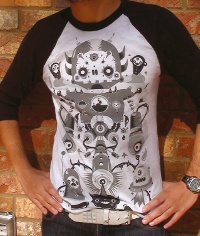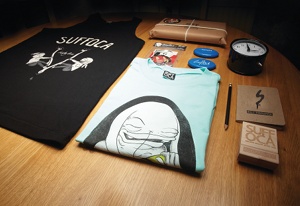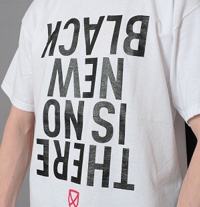Start a clothing brand: 7 tips for designers
Want to start a clothing brand? It isn’t as tricky as it sounds. Rob Carney meets some of the illustration entrepreneurs appearing on bodies all over the world.

It does sound like a huge task, but it isn’t actually that difficult to start a clothing brand. Sure, a huge company such as WESC, Stussy, Addict or Obey may be a little out of reach for the time being, but as an illustrator or designer wanting to find another outlet for your work, and make a bit of cash with not too much effort, T-shirts and the like can be a great income-generator. Not only that, but they get you, and indeed your work, close to other designers’ and illustrators’ hearts – quite literally.
In this article we've spoken to some experts in the field, who give advice in seven crucial areas you need to bear in mind. Follow their advice and you'll soon be on your way to starting a clothing brand...
01. Stay original
When you come to start a clothing brand, the big question is: what do you put on tees or other items of clothing? It’s almost certain that you’ll have to adapt your style or come up with designs from scratch.Ben Hasking, who runs Bake Designs in Bristol, UK – a clothing company he set up just last year – believes one of the hardest challenges in a highly competitive market is staying original. “And staying original applies in a number of different ways,” he begins.
“Firstly, you need to create something original and different, but you want it to be popular and sell well, so it’s very easy to follow current trends and sacrifice originality. Secondly, any strong brand will have a solid style or direction, so creating designs that fit that style without feeling bland or repetitive is important. Some brands get it spot on, others don’t. It isn’t easy.”
02. Focus on customer need
But the process of starting a clothing brand isn't all about going wild with creativity - you have to remember this is a business.
Mercedes Crespo, who runs her own small brand, Yema Yema, out of Atlanta, Georgia, agrees that it’s important to be original, but at the same time stresses that you must give your audience something they want to buy, which sometimes involves reigning back your own creativity.
"I’m all for creating something unique," she says, "but I also have to consider that people like to relate to everyday things, and mixing the two has been the biggest challenge for me when designing.
Get the Creative Bloq Newsletter
Daily design news, reviews, how-tos and more, as picked by the editors.
"I like to let my mind explore when I’m drawing – there is a lot of character and personality in my designs, from the bright colours to the crowded composition. It has a bit of playfulness, but also a bit of darkness and mystery.”
For Crespo, whose bright, quirky character-led illustrations incorporate, in her own words, “the soul and playfulness of childhood mixed with some of the darkness and secrecy that adulthood brings,” she sees her T-shirt business as a way to grow and evolve as an artist, but also recognises the need to approach her customers to see what they like.
“I’ve noticed that people tend to like and relate to things they recognise as familiar,” she says. “I try to find a good balance between the crazy characters that I love to make, and the more recognisable characters. I also love to try different things once in a while and see how people react to it, But above all I always try to keep the Yema signature and style in everything I do.”

Hasking reveals that it’s a fine line between doing what you believe is right and what your customer needs. “You can’t forget that fact, and it’s very easy to pander to what you think your customers like at that moment or what they are buying,” he says.
“If you’re running a brand, sometimes you have to be brave enough to tell your customers they’re going to like something and they’re going to buy it. That’s how trends start and fashion progresses. You want to make sure that you’re a leader, not a follower.”
03. Build trust with suppliers
When you start a clothing brand, one of the main things you'll need to consider is suppliers, and in particular, how to build relationships with them.
Lewis Boyce has run Suffoca since 2008, which he started with a small collection of savings from a part-time job. He explains the origins: “I began to document a group of hand drawn characters with unordinary adventures that I then developed into collectable products. There is a strong DIY ethic in the brand, from extra details, custom packaging and hidden hand-stamped finishes.
Suffoca is sold exclusively online through the Suffoca Shop, so I can keep my own personal touches on all the orders and its presentation.”
Boyce’s unique personal touches and custom packaging raises the question: how do you actually get your products made? Boyce has some good advice: “When working with a supplier and producer the first thing I would say is build up trust with them,” he says.
“Check out previous and current clients, ask for samples and talk over your idea – if they are a good company they will offer you advice. Make sure you’re ready – most ideas have been covered somewhere or other, so there’s no rush to push your product out before it’s fully ready. These extra steps may make the procedure longer and more costly, but it is well worth it.”
Crespo agrees: “There is a lot to learn when it comes to choosing a printer. There are so many printing methods and many shirt styles out there. So far it has not been too hard since my designs are pretty simple to print. Figuring out what sizes and how many of each can be tricky. My only advice is to make sure that you are happy with the print job – if you see any mistakes or something does not look right, make sure you tell them nicely. Remember those shirts will be representing you and your brand, and you want only the best for your customers.”
04. Quality control

Hasking jumps in, backing up Crespo: “Quality control is very important to me and I think, from that point of view, it has been very challenging,” he says. “There are always issues and sometimes you have to be seemingly fussy or a little anal to make sure everything is perfect. You have to remember that at the end of the day you’re putting these products out into an already saturated market. And some of the brands populating this market have been doing it for years, so every little detail makes all the difference when trying to match up alongside the big boys.”
He continues, echoing Boyce’s words: “The easiest way to keep an eye on quality control is to build relationships with the people responsible for production. The closer you can be to these people, the closer you can be to your products and the closer you can be to picking up on the little details that can separate you from the next BigCartel brand. Alternatively, if you want to have complete control over the quality of your products you can do the printing yourself, but you have to ask yourself whether it makes financial sense as well.”
05. Marketing your wares
Of course, just having products is not enough. If you’re going to be a success people need to know about your wares. Crespo relays the challenges. “Honestly speaking, that has been the hardest part for me,” she says. “At the end of the day, I am just an artist. I never took marketing classes or business administration, and when I started Yema I did not have any connections. I’ve had to learn lots of skills, from approaching different blogs and introducing myself to walking into stores to talk about my brand. I believe the best marketing technique is word of mouth – it’s the hardest to achieve but it tends to work the best. My best advice is to just talk to people, approach them, ask questions and always be friendly.”
Boyce continues: “The Suffoca brand is built around a series of characters,” he says. “My website has a section in which you can see the characters and read each of their stories; like any story or adventure this gets passed by word of mouth. I believe if you make good products that people relate to, they will share that experience with others. Being social with friends and customers is the best way to market yourself.”
06. Passion pays off
“My one piece of advice to anyone starting a brand would be to only do it if you are really passionate about it.” says Ben Hasking. “Don’t just start a brand because you think it’s cool or easy or you just want to make some quick cash.
"Running a brand is a labour of love – you have to put in work and put in hours. It’s not gonna make you a bundle of money, not yet anyway, so you have to really want to do it.”
07. Growing the business
Once you have a marketing plan – which may be as simple as going to see local and regional shops and setting up a Twitter and Facebook account, it’s time to grow. Crespo has big plans for Yema Yema in the coming years: “I want to expand my product line to sweatshirts – which I plan to release at the end of the year – a kids’ line, accessories and, of course, my biggest dream is to make collectable toys that come with every T-shirt you buy. I think that with fresh ideas and simple yet eye-catching designs things will move forward. This has been a fantastic year so far for Yema and I hope that with hard work and dedication 2012 will be an even better year.”
Concluding, Hasking laughs: “A few years ago starting up something like this would have been an absolute nightmare, but now it’s all made so easy. It’s all at your fingertips. Facebook and Twitter give you a direct link to your customers and obscure celebrities.
"Tumblr gives you a way to keep those customers updated and post pictures of cats and hot girls in Air Max. And BigCartel and Shopify make setting up an online store simple. It really is all just given to you on a plate, but that doesn’t mean you don’t have to work at it and engage with your customers and the community through those outlets. Do what you can to get seen, find your target market and work out how to engage with them.”
Liked this? Read these!
- How to build an app: try these great tutorials
- Download the best free fonts
- Free Photoshop brushes every creative must have
- Free tattoo fonts for designers
- Free Photoshop actions to create stunning effects
- Discover what's next for Augmented Reality
- Download free textures: high resolution and ready to use now

Thank you for reading 5 articles this month* Join now for unlimited access
Enjoy your first month for just £1 / $1 / €1
*Read 5 free articles per month without a subscription

Join now for unlimited access
Try first month for just £1 / $1 / €1
The Creative Bloq team is made up of a group of design fans, and has changed and evolved since Creative Bloq began back in 2012. The current website team consists of eight full-time members of staff: Editor Georgia Coggan, Deputy Editor Rosie Hilder, Ecommerce Editor Beren Neale, Senior News Editor Daniel Piper, Editor, Digital Art and 3D Ian Dean, Tech Reviews Editor Erlingur Einarsson, Ecommerce Writer Beth Nicholls and Staff Writer Natalie Fear, as well as a roster of freelancers from around the world. The ImagineFX magazine team also pitch in, ensuring that content from leading digital art publication ImagineFX is represented on Creative Bloq.
